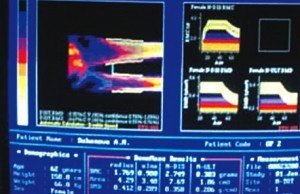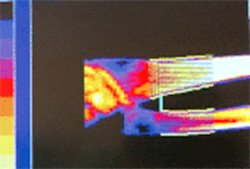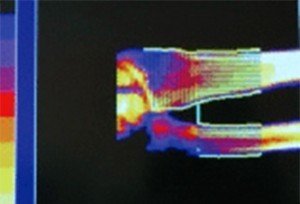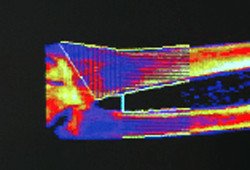Osteoporosis is considered as the most dangerous human diseases, such as oncology, myocardium infarction, and stroke. For its diagnostics and determination of therapeutic activity of various preparations may be used numerous research methods, laboratory, hystological, X-ray methods, in particular, research of biochemical markers of bone metabolism – osteocalcin, parathyroid hormone (PTH), 25(ОН) D, Beta-Cross Laps of blood serum, etc. Determinations of the last ones is not always suitable for control of effectiveness of osteoporosis therapy, especially, when osteoporosis is developing on the background of rheumatoid arthritis, multiple myeloma, etc. Histomorphological analysis of bioptat of iliac crest is regarded as the most reliable parameter in diagnostics of osteoporosis. However, invasive character of this method limits its use. The most accessible method in diagnostics of osteoporosis is a common roentgenogram. But it relates to the late diagnostics since it allows to diagnose osteoporosis only after the loss of bony tissue is more than 30-40%. It is little sufficient for evaluation of therapy. So, the most precise and informative method of determining of bone mineral density (BMD) in vivo in various parts of human skeleton with the aim of diagnostics of osteoporosis and evaluation of effectiveness of therapy is X-ray absorptiometry.
Modern densitometers allow calculate the main parameters of bony tissue: bone mineral content (BMC), bone mineral density (BMD in g/cm2). According to the classification of WHO, the normal BMD characteristics must have standard deviation (SD) from peak bone mass from +1 to -1 on the base of T-test. Osteopenia of I-III degree gives BMD from -1 to -2.5 of SD. Osteoporosis gives BMD from -2,5 of SD and less.
So, the diagnostics of osteoporosis is carrying out presently in accordance with these criteria. But the single feature of decrease or increase of BMD it not always sufficient to correctly diagnose and, furthermore, correctly evaluate effectivity of a preparation in treatment of osteoporosis. As it has appeared, the severity of postmenopausal osteoporosis and effectiveness of a preparation can be considered only in view of morphological manifestations of disease [1-3]. Without it, severity of disease and effectiveness of preparations are difficult, and sometimes even impossible, to determine (for example, in the case of atypical osteoporosis). See the example of osteodensitometrical research in one patient, female, in whom the osteoporosis was not diagnosed on the results of BMD research (Fig.1).
Thus, detection of bone cavities has a great importance to clarify the diagnosis. Furthermore, positive or negative dynamics of chanhges in dimensions of bone cavities can serve as a sign of effectiveness/noneffectiveness of a preparation. However, most of densitometers “do not see” bone cavities because they are configured only on the determination of quantitative BMD characters, and it is their main drawback.
Densitometer such as “Osteometer DTX-100” allow at the same time determine not only quantitative characteristics of BMD, but also morphometric parameters (cavities and excessive salt deposits in soft tissues). Unfortunately, these functions were not demanded.
It was concluded during the sturdy that it is impossible to consider the effectiveness of a preparation for treatment of osteoporosis when basing only on quantitative data of BMD [2, 3]. So, for example, a patient S, female, was treated with a preparation “Bivalos”. The results of 10-month of treatment: increase of mineralization from -3,4 to -2,4 of SD, and of bone cavities. So, if this therapy is judged by BMD, it could be considered as positive result, and, consequently, the preparation is effective. But when we consider dynamics of disease, taking account of the morphometry of bone cavities, so the final conclusion would be another: worsening of osteoporosis due to increase of bone cavities, and as a result – increase of a risk ok of bone fractures, i.e. “Bivalos” is ineffective because of the lack of regeneration of bony tissue.
At the present time for prevention and treatment of osteoporosis are used many preparations which are predominantly imported. In these conditions, it is difficult to a practicing physician to chose effective osteoprotector for traetament of osteoporosis.
Well-organized advertizing only makes this choice more difficult. Therefore, development of methods of diagnostics of osteoporosis and of determining of effectiveness of various preparations for treatment of this disease are great practical importance.
The aim of this study is to determine possibilities of choice of optimal preparation for treatment of postmenopausal osteoporosis, and to consider its effectiveness in women with androgenic deficiency on the base of examples of the use of Russian preparation “Osteomed forte”.
Experimental phase.
In the period from 2009 to 2013 The Osteoporosis research center of Penza institute of physicians’ postgraduate training had examined 82 patients – women from 49 to 85 years old. The patients were selected for examination according to following criteria: women with postmenopausal osteoporosis, hormonally and clinically confirmed androgenic deficiency, bone mineral density (BMD) less than -2,5 of standard deviation (SD) and presence of cavities in trabecular bones.
For the determining of bone mineral density by X-ray absorptiometry method was been used device «Osteometr – DTX – 100». It is the only type of device that can simultaneously detect BMD and presence of cavities in bones. The examination of patients included collection of medical histories, general examination, medical tests (incl. radiologic tests and clinical chemistry), as well as hormone investigations to determine amounts of bioavailable testosterone, sex hormone-binding globulin (SHBG), thyroid-stimulating hormone (to exclude patients with hypothyroidism). Hormone investigation was performed using immuno chemiluminescence method and «Immulite 2000» device. Severity of osteoporosis was evaluated according to the Classification of World Health Organization (WHO).
As criteria for evaluation of activity of «Osteomed forte» for the treatment of osteoporosis were taken: capacity of a preparation to increase BMD, to close or reduce dimensions of cavities in trabecular bones, increase of muscle power, reducing of falls, absence of new fractures, and increase of motor activity.
Quantitative analysis of pictures were carried out with help of produced by us the computer system in a programming language Delphi. For these purposes, dimensional graphical images were presented as dimensional array of data-pixels. Calculation of the area of color places, analysis of their dynamics were carried out by counting the number of corresponding pixels. With repeated study, taking into account the sixe of original graphics, we calculated the actual area of affected places after treatment.
Depending of the method of treatment of osteoporosis all the tested women were divided into three groups, correlated by age and severity of disease. The first group (38 women) was administrated by «Osteomed forte», taken orally 1 tablet two times per day at morning and before sleep; the treatment included 3-month course of treatment three times in the year, with permission of the Ethic Committee. (One tablet contained 500 mg of calcium citrate, 100 mg of drone brood, 500 IU of vitamin D3).
The second group (34 women) was taken «Calcium D3 Nicomed», containing in one tablet 0,5 g of Calcium, using the same scheme of administering as in first group.
The third group (10 women) was taken “Bavalos” (strontium ranelate) 1 sachet (2 g per day) before sleep.
All patients were examined before the administration of preparations and after the therapy in order to determine bone mineral density and dynamics of development of bone cavities using X-ray absorptiometry method.
Statistical assay of the received data was performed using the program packet StatSoft, Windows XP. Quantitative values are described taking in account the average and standard deviations. Received data are presented in the format M±m, where М is an arithmetic mean, and m – error of mean. Distinctions were considered as statistically significant when significance level is р<0,05.
After the end of 10-months treatment course 29 patients (76±7%) from the first group of women, treated with «Osteomed forte», showed the more visible therapeutic effect: 19 women (49±8%) – reducing of bone cavities, 10 women (27±7%) – closing of bone cavities.
In the second group of tested, treated with «Calcium D3 Nicomed», positive changes were observed in 13 (38±8%) women in comparison of results with first group (М±m=76±7%), р<0,05.
In the third group, treated with “Bivalos”, positive changes in reducing of bone cavities were observed in 2 women from 10 patients, in comparison with the first group р<0,05. The better results of treatment with «Osteomed forte» can be explain by the presence of drone hormones, serving as a substrate for synthesis of necessary hormones in patient’s own organism. The analysis of hormone values showed that concentrations of available testosterone among women from two tested groups before treatment were: in the first group – 1,1±0,4 nmol/l, in the second group – 1,2±0,5 nmol/l (р>0,05) at reference ranges for present method 1,7-3,4 nmol/l. Ten months later, after the treatment with «Osteomed forte» was remarked increase of available testosterone concentration in blood serum from 1,1±0,4 nmol/l (before treatment) to 2,5±0,6 nmol/l (after treatment). Patients from the second group, treated with «Calcium D3 Nicomed», showed no positive changes in testosterone level. Women from the third group demonstrated no reliable changes in hormonal status after treatment as well as before treatment.
The group of patients, treated by “Bivalos”, showed the lowest rates of effectiveness of treatment because a positive result may be obtained only aftre durable treatment – up to 60 months [4]. It is 3-4 times longer than a therapy with “Osteomed forte”.
Furthermore, the main disadvantage of “Bivalos” is its high price: 28 sachets cost from 2000 rubles per month and more. It is 4-5 times higher that the cost of “Osteomed forte”. There is the cause, why the third group od tested patients was so few. The majority of pensioners can not simply aollow themselves to buy “Bivalos”. Furthermore, in the process of treatment were observed such side effects as diarrhea (2 persons), exacerbation of gastritis (2 pers.), headaches (1 pers.), The treatment with “Osteomed forte” and “Calcium D3 Nycomed” gave no such side effects.
Figures 2, 3 presents examples of closing of cavities in patients (females), treated with “Osteomed forte”. The osteometry, performed before treatment detected bone cavities (Fig. 2a, 3a – before treatment). After 10 months of treatment with «Osteomed forte» cavities have closed (Fig. 2b, 3b).
The results of the carried out study clearly proved, that the preparation “Osteomed forte”, in comparison with other tested preparations, normalizes the level of androgens in women. It results in improvement of general condition of patient, increase of BMD, and reducing of cavities in trabecular bone or their closing.
The mechanism of the positive action of “Osteomed forte” on morphological manifestations of osteoporosis is not completely understood. According to the opinions of some authors, deficiency on androgens plays important role in development of postmenopausal osteoporosis [5-8]. In the case of age-depending osteoporosis in women it is observed the decrease of the level of all androgens. S.Kalinchenko et al. supposed, that the use of androgens in treatment of osteoporosis is justified. But because the use of natural estrogens and androgens have some disadvantages we proposed to use drone brood as donator of sexual hormones (Patents №2497533, 2498811) [1–3].
On the base of obtained results we can conclude that the high therapeutic effect of “Osteomed forte” is caused by the presence of drone brood as one of its ingredients. The last is donator of androgens, stimulating production of own sexual hormones in women with postmenopausal osteoporosis that influences on their BMD. It can be proved by the fact that women with postmenopausal osteoporosis after the course of treatment with “Osteomed forte” the concentration of total testosterone in blood serum was increased from 1,1±0,4 to 2,5±0,6 nmole/l (р<0,05). In the two groups, treated with “Calcium D3 Nycomed” and “Bivalos”, there were no positive changes in testosterone level.
Thus, deficiency of sexual hormones in the postmenopausal age is the main cause of morphological changes in trabecular bones with formation of bone cavities as consequence of enhanced resorption of trabeculae.
Morphometric control of these changes allows verify with great accuracy the diagnosis of osteoporosis and determine the effectiveness of chosen preparation or preparation complex.
The Penza institute of physicians’ postgraduate training is carrying out studies which are intended to research possibilities of various osteoprotectors in closing of osteoporotic bone cavities. Received data about closing of bone cavities are the great importance for further development of strategy of treatment of postmenopausal osteoporosis.
Conclusion
- Determining of bone mineral density (BMD) in combination with morphometry allows not only improve the diagnostics of osteoporosis, but also to choice individually the most effective preparation for treatment.
- From 3 preparations chosen for determining the most effective among them during 10-month treatment of osteoporosis, “Osteomed forte” proved its most effective effect. By improving the hormonal status of patients (women) in postmenopausal period it allows not only suspend, but even achieve regression of the disease.
- Proposed methods od diagnostics of osteoporosis as well as determination of the most effective (and cheap) preparation(s) allow not only increase the effectiveness of therapy of osteoporosis in aged persons, but also to give economic effect that could be calculated in billions of rubles.






